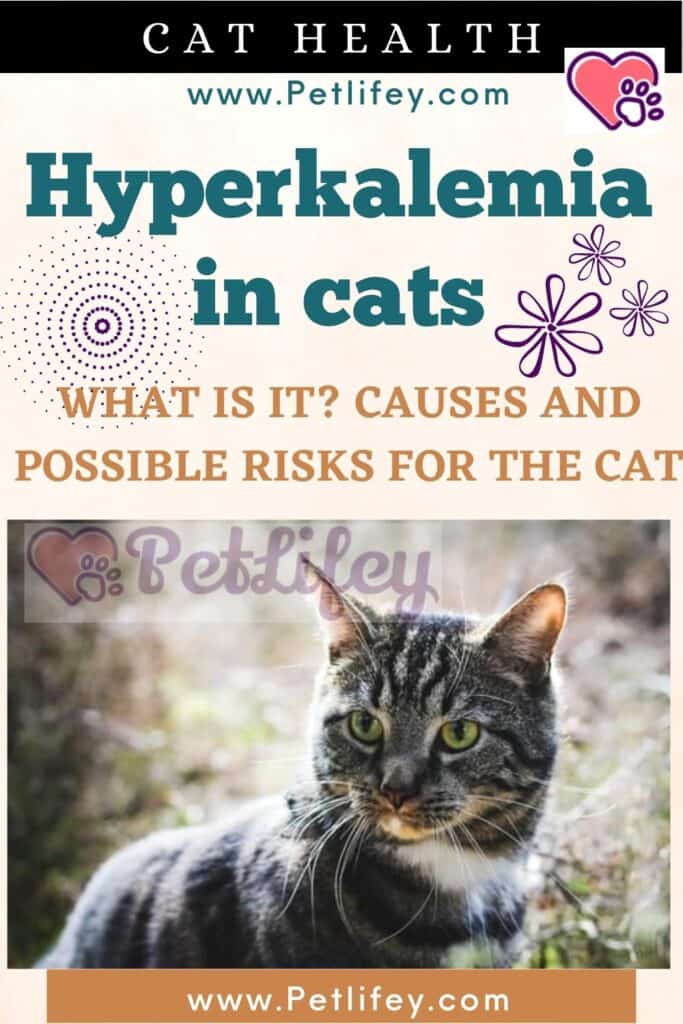Our cat may have something wrong with his blood tests. What is hyperkalaemia and what are the risks of cat?

Sometimes while reading our analyses we focus better only on those with an asterisk, but it would be advisable to have the doctor explain the meaning of each item. The same applies to our cat’s blood tests. The alteration of some values can be the signal of an on going disease, as in the case of a hyperkalemia. But what is it and what risks does the cat run?
Hyperkalaemia in cats
Everything that is absorbed from food is released into the bloodstream and can be measured: when the values of the fundamental indices for the organism are normal, it means that everything works.
Sometimes, however, the values can also be within the limits but there is already a disease in place : this happens because compensation mechanisms come into play that try to defend themselves from the triggering cause.
Going to measure the quantity of minerals in the blood, in the form of ions with an electric charge (electrolytes), it is possible to find a value below or above the norm: when you find too much potassium in the cat’s blood, you have the hyperkalemia.
Potassium, in the form of K + (ion with a positive electric charge), is essential for the functionality of the cells in the cat’s body:
- Together with sodium (Na + ) it is responsible for the exchange of cellular fluids from the inside to the outside and vice versa;
- It intervenes in the urine filtration mechanism in the kidney;
- It is fundamental in the contraction of the smooth muscle of the blood vessels : without potassium there could be no balance of blood pressure;
- Together with calcium (Ca ++ ) it is responsible for the conduction of the electrical impulse between the nerve fibers of neurons;
- Together with sodium, it constitutes the sodium potassium pump in the heart muscle: through the use of energy, the alternation of sodium or potassium entry into the cell is exploited to introduce other nutrients;
- It is responsible for cardiac contraction and therefore for the functionality of the heart.
Consequently, if our cat had low potassium one of the symptoms they would have would be muscle cramps. But what if instead the potassium in the cat was excessively present in his blood?
There are many causes that could lead to hyperkalemia :
- Chronic renal failure;
- Obstruction of the ureter;
- Heart failure;
- Malfunction of the adrenal glands;
- Metabolic acidosis;
- Diabetic ketoacidosis;
- Hemolysis: red blood cells undergo destruction due to an unexplained increase in catabolism in the tissues;
- Low aldosterone value;
- Muscle trauma: when a muscle is severely damaged, the components all pass into the blood, including potassium;
- Increased cholesterol and triglycerides in the blood;
- Trauma to the urinary tract;
- Administration of drugs such as antibiotics or diuretics.
At some point we may notice that our cat begins to feel unwell: the muscles of his paws appear weak and his reflexes are blurred. We could think of them all but you need to take him to the vet right away.
After a thorough examination, the doctor could detect tachycardia in the cat and also the electrocardiogram could be altered: if the situation were serious the cat would also have respiratory failure and risk cardiac arrest.
Obviously, the therapy will be based on adopting all those mechanisms aimed at lowering potassium in the blood plasma, with drugs but also by resorting to hemodialysis for our cat if necessary.
To consider

There are some symptoms, such as those that gives hyperkalemia, which could lead to various pathologies and it is up to the veterinarian to trace the precise one.
Undoubtedly, if our cat was of an advanced age, a renal insufficiency in the cat could already be underway : in this case an increase in potassium in the blood is closely related and the doctor will carry out frequent tests on the cat to monitor it.
Of course, if we only thought that the heart could be affected the most, obviously we would be very worried. We also know how much the choice of food to include in its diet affects the general well-being of the animal.
The diet for a cat with renal insufficiency, in fact, is very different from that for a cat in full health: it is necessary to facilitate the function of the kidneys and not overload them.
The same reasoning applies if the heart suffers from insufficiency: anxiety and stress are never good for you and you must avoid foods containing large amounts of potassium, such as salmon, chicken or spinach.
In most cases, hyperkalaemia in cats occurs as a complication of other diseases and, although it does not happen very frequently, hospitalization may also be required should the cat undergo hemodialysis .
On the contrary, regardless of what may be the cause of the hyperkalemia, it always happens that our cat feels exhausted, apathetic and for fear of feeling bad at times it could even avoid moving as it did before.
There is also always the symptom of lack of appetite in the cat that shows high levels of plasma potassium, and you need to know how to encourage the anorexic animal to eat so that it does not become too weak.
The important thing is to follow the veterinarian’s instructions and not to create tension and anxiety at home: the medicine will take care of relieving the unpleasant symptoms of decompensating in the cat, the rest is entrusted to all our love for cat.






